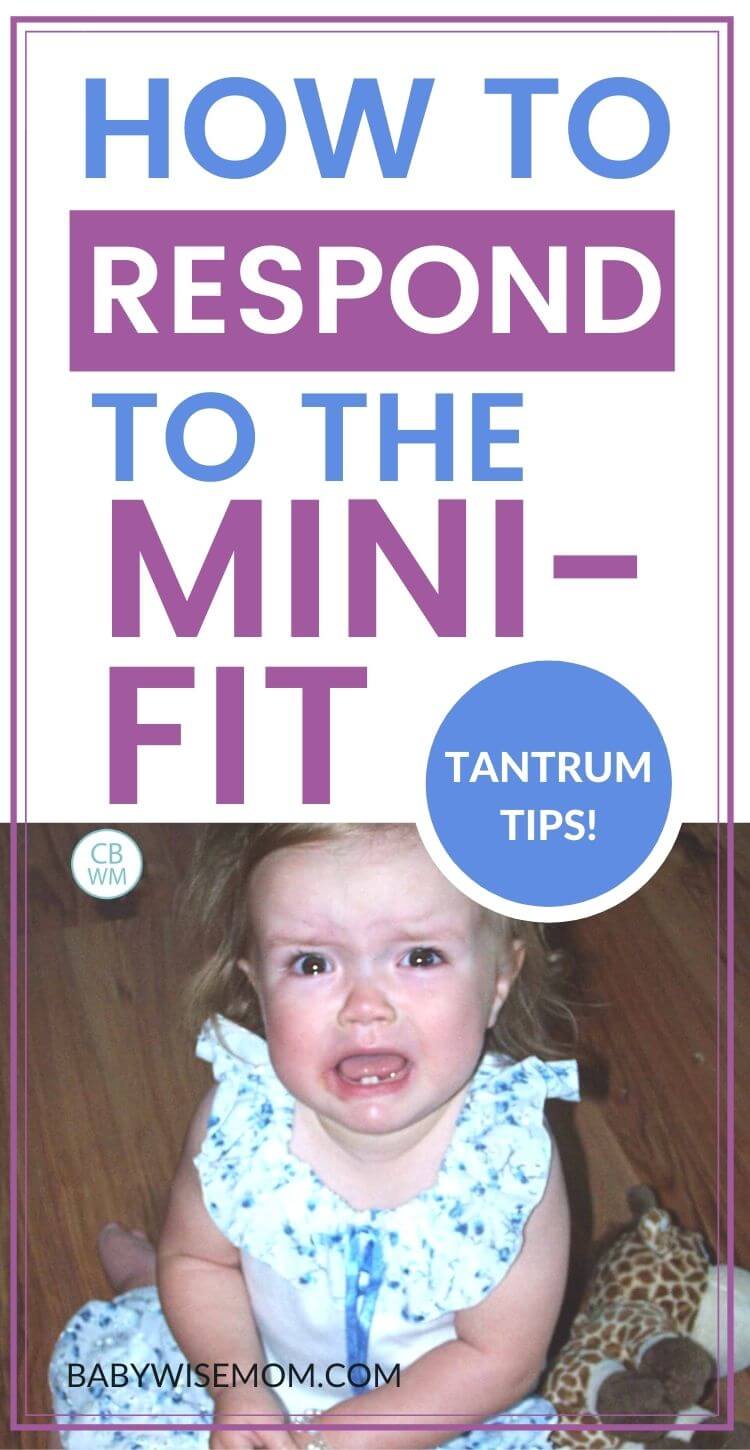What to do when your child has a mini-fit. How to solve the early tantrums your pre-toddler and toddler have. Strategies to stop tantrums.

The mini-fit.
Ugh.
The first time Brayden, my oldest, threw a mini-fit, I think my heart started to race. My mind started to race.
I wasn’t exactly sure how to react.
Sure, I had read about how to react, but reading about it and actually facing it are two different things.
What was I supposed to do? Where had I gone wrong?
Little did I realize this was just a mini fit and not a full on tantrum.
Mini-fits are almost comical when compared to a tantrum. The mini-fit is likely to creep up somewhere around 9-10 months, though some have them sooner and others later.
If you have an older toddler, this post is not for you. Toddlers have real fits. Tantrums. See How To Stop a Tantrum and Tantrums and Discipline for help with toddlers.
Like I said, Brayden’s first mini-fit sent me into a panic. I wondered what had I done wrong? Why was he acting this way? What was I supposed to do?
His first mini-fit happened right on schedule. He was pretty textbook about things. By the time he was 12 months old, he was really good at obeying me because we had a lot of practice with me correcting him. The mini-fit did still make me nervous at times, though–especially in public.
With Kaitlyn’s first mini-fit, I didn’t even bat an eye. I actually had to suppress a smile. Her mini-fit came at 14 months old. I just thought to myself, “Sorry, girl, you have a 3 year old brother. That mini-fit is not going to phase me.”
I am guessing a lot of people are curious what her mini-fit was all about. She was in the wading pool, but wanted to play with the playground gravel.
She liked to put the gravel into the pool or the sandbox, which are both no’s. I told her she couldn’t play with the gravel while she was in the pool. Well, she lost it. She cried and cried.
I took her out of the pool and held her. I said she could play with the gravel once she calmed down. She wiggled and tried to get down to the gravel and continued crying.
I told her she could play as soon as she stopped crying. She was mad. She cried for a couple of minutes and then stopped. Then I let her play with the gravel.
Post Contents
A Mini-Fit is a Pre-Tantrum
If you are a first time parent, you will probably see your first mini-fit as a huge deal like I did. The mini-fit is really a pre-tantrum and is a good way to practice your resolve.
This is the first version of the tantrum. Tantrums come later in toddlerhood. Bad tantrums will come later–closer to two.
These min-fits will slowly intensify (or suddenly intensify). Many toddlers get a bit jump in their “fit” abilities around 18 months.
We know tantrums happen. And please recognize that it happens.
The mini-fit does not mean you are a bad parent. It doesn’t mean your child is a bad child. No child is going to make it through life without ever throwing a fit or tantrum.
It is normal.
That doesn’t mean you accept the behavior, but it does mean you can move forward without harping on yourself and wondering how you have failed.
Sometimes the fits will come more often if you give in to them or have other gaps in your parenting. Adults also throw fits, but we get better at both controlling our emotions and dealing with those emotions. We need to teach our children to do the same.
How to Deal with Little Tantrums (a mini-fit)
It happens. The mini-fit is normal. Normal doesn’t mean acceptable. It doesn’t mean we allow it to happen. We want to teach our children how to react differently than a fit. How do we deal with the mini-fit?
Do Not Give In
I would number one never give in to the little mini fit. At first, the mini-fits aren’t long enough that you really even consider giving in. They are over as quickly as they start. As your child gets older, the mini-fits will get longer. Just don’t give in from the beginning.
Don’t give in even if the child’s desire is okay with you.
Take Kaitlyn’s gravel fit. She wanted to play with the gravel. That is fine with me. It isn’t fine with me for her to do so while she is in the pool.
I told her no and was about to offer options when the fit broke out. I could have lifted her out and on to her towel in the gravel and she would have stopped her fit.
But I didn’t want to teach her that a fit gets her what she wants. She needed to work through her fit first.
Offer Choices
Offer choices. You might think your child is too young to understand you, but they understand much more than you realize. “You may not play with the gravel while in the pool, but once you get out of the pool you can. Are you all done in the pool?”
Be Empathetic
Be empathetic and understanding to your child’s frustrations.
I would tell her “I am sorry you are upset (or I know you are upset), but you are not allowed to play in the gravel while in the pool.”
I would then let her have her expression of frustration. Just don’t give in (reiterated!) while the fit is happening.
Sometimes we just need to let our emotions out. These pre-toddlers and early toddlers are just now experiencing these emotions. It is hard for adults to deal with them, so don’t expect your child to be a pro.
The things that are trivial to you are your child’s whole world. The gravel is very important. If she needs to have a little crying session, that is fine. She will learn to deal with that emotion if you let her. Suppressing it is not the answer.
Teach Appropriate Outlets
Along those lines, teach her the appropriate outlets. It is okay to have frustration; they don’t need to have a meltdown every time they are disappointed, but I do think it is normal to have some expression of frustration every now and then.
As Brayden got older, we had a designated chair for him to go to if he was too upset. He was allowed to have his crying session in that chair. He couldn’t sit at the dinner table and cry, he needed to sit in that chair.
One day when he was four, he was about to lose it and I asked him if he needed to go sit in the chair. He responded “Yes” and left the room to the chair. He was there for about a minute.
He came back just fine. He had collected himself. He was ready to be mature about things. Teach your little one where she can express her emotions (somewhere that isn’t disruptive to the family) and how. Set some ground rules for these outlets.
Teach Communication Skills
Teach her to communicate. Many of these min-fits come as a result of the child not knowing how to express themselves.
I think this is one reason Kaitlyn’s fits came so much later. She didn’t have communication fits because she is so good at communicating. It is a real talent of hers. I also started sign language at a very young age with her (see How To Teach Your Baby Sign Language).
With Brayden, he had a lot of fits around communication. I started teaching him sign language around 14 months old and his fits really decreased.
If you find a common trigger for fits, help your child learn to communicate to avoid those fits. For example, if your child throws a fit in order to get out of the highchair, teach her to sign all-done. Then she can ask in a way other than a fit.
As they get older and the fit lasts longer or they persist, I say “even if you throw a fit, you can’t do it/can’t have it.” I am re-reiterating: Don’t give in.
Stay Consistent with Rules and Expectations
Stay consistent with your rules and expectations. Don’t confuse your child by giving in sometimes and not others. Don’t switch the rules on them. Of course, if you realize a rule needs to be changed, do it, but don’t go back and forth like a ping-pong.
As you continue on through your parenting, this will all become second nature to you. You won’t have to think through. You will be consistent and gain confidence in yourself and your child. You won’t worry so much while in public.
Mini-Fit In Action
One day when Brayden was four, we were at the park with about 12 other moms with their kids. Brayden went running off with a friend while carrying his drink. I like the drinks to stay on the blanket so they don’t get lost in the oblivion of the park. I called after him to leave his drink with me.
He wanted to take it with him. I told him no, he needed to leave it with me. He started to insist upon taking it when I gave him my mommy-look and he brought back. This isn’t a shining example in first time obedience by Brayden, but is an example of me sticking to my rules even with lots of moms watching.
It is a risk to insist upon obedience in front of people. If your child refuses, you know you will look really bad. You know there will be some understanding mothers, but you also know there will be mothers who start to think about all the things you are doing wrong.
As Brayden brought his cup back, I realized that in that moment, I had basically blocked out all the other mothers. In that moment, it was me, him, and the cup.
I gave an instruction and insisted upon his obedience, and he obeyed. I was happy to know that I am confident enough in myself and in him to not worry about what others are thinking.
Conclusion
Once again, I implore you to not give in to the mini-fit. Trust me when I tell you those mini-fits will get a lot worse in intensity and happen more often if you choose to give in.
Tantrums will get even worse if you give in.
If you set ground rules and expectations now, future tantrums will not be as bad. They will still come, but will come less frequently and with less intensity.
Related Discipline Posts on This Blog
- How to Get Your Child to Obey with a Simple “Yes Mom”
- Tips for Avoiding and Responding to Tantrums
- When Your Child Has a Tantrum, Stop and Think
- Teaching Your Baby to Listen to “No”
- The Choice Addiction (for Toddlers)

This post originally appeared on this blog July 2009

